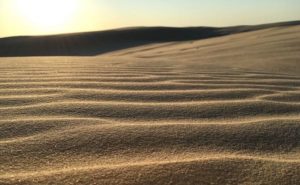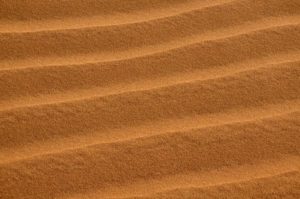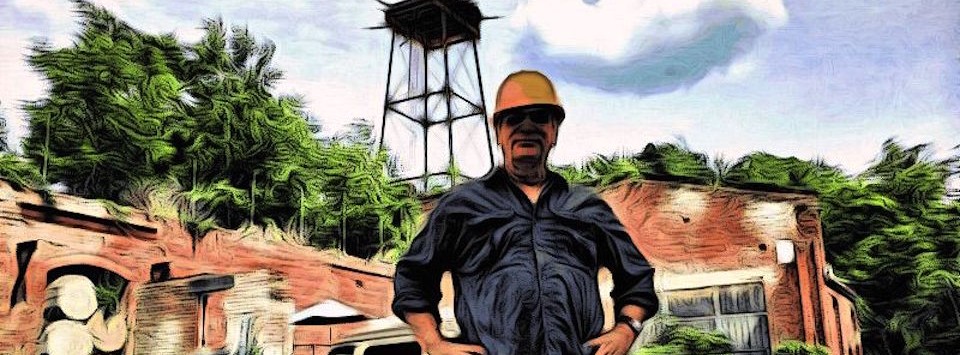Archives: Sand Business
Counting Our Grains

My good friend Jeff Mann, the true Yard Ramp Guy, has asked me to revisit some of my original posts. This week in my From the Archives series: is sand an endangered, er, species?
Air and water are our two most heavily-used natural resources and, though not as obvious, dirt is number three. What's number four, though?
Surprisingly enough, it's sand.

Endangered?
We’ve used sand for construction since the time of ancient Egypt, if not longer. We utilize certain high-grade sands for glass, with other grades for detergents, toothpaste, cosmetics, solar panels, and computer chips.
The biggest use? Concrete. Essentially, concrete is just sand and gravel bound together by cement.
You might wonder why I'm distinguishing between dirt and sand. They're both just stuff on the ground, right? Well, no. Dirt contains a high degree of biological debris and is great for growing things in. (It often contains sand.) Sand is just ground up bits of minerals, usually quartz.
As common as sand is, turns out that it's also a finite resource. Humans use more than 40 billion tons of sand and gravel every year, and the demand is getting severe enough that riverbeds and beaches all over the world are being emptied out. We can't use desert sand because it's too rounded to bind together well—a result of wind erosion rather than water erosion.
And shortages are beginning to crop up. The absurd construction boom in Dubai has so denuded local sources that they're literally buying and shipping their sand from Australia now.
As local riverbeds, beaches, and quarries run out, sand miners have started to turn to the seafloors, vacuuming up sand from the seabed while dealing marine ecosystems massive amounts of damage.

Alarming ripples.
At least two dozen Indonesian islands are simply gone now due to Singapore's sand requirements (its artificial land construction projects make it the largest sand importer in the world). Environmental damage in the region has gotten so bad that three countries have already banned exports of sand to Singapore.
Construction sand now even has a black market, profitable enough that violent organized crime groups are building up around it.
The environmental damage from the sand trade is immense. This hardly gets any attention in much of the world. After all, it's just sand, and for millennia now we've used “grains of sand” as a metaphor for something countless.
Our sand turns out not to be countless after all.
Yard Ramp Guy Blog: The Transaction
This week, my friend The Yard Ramp Guy tells a story that's good karma for the business soul.
Click HERE to become one with the industrial yard ramp universe.

Archive: Your House is a Fossil Museum
Or: Kitty Litter Paleontology

My good friend Jeff Mann, the true Yard Ramp Guy, has asked me to revisit some of my original posts. This week in my From the Archives series: what's that archaeology team doing in my kitchen?

My watchdog never needs walking.
We usually think of fossils in the context of museums, but you might be surprised to hear that they're probably in your home without you knowing.
The first way this happens is pretty obvious: if you've got limestone as part of the construction of your house. Limestone is almost universally fossil-bearing. In fact, many types of limestone are almost entirely made up of fossils. So, if you have limestone in your house, you've probably got fossils.
Of course, fossils can be found in other rocks as well, such as certain sandstones and mudstones, though limestone is the most common fossil-bearing rock used in construction.
Next is in kitty litter. Bentonite clays are used in countless industrial settings, but they also have one extremely common use inside the home—as the main ingredient of most kitty litter products. Bentonite clay is highly absorbent, making it ideal for this purpose.
Another thing bentonite clay is famous for? Occurring near fossil formations. The Morrison Formation, the geological formation where Dinosaur National Monument is found, is also heavily mined for bentonite clay. There have also been plenty of reports of kitty litter mining companies in Canada knowingly destroying fossil beds for more profit. So... your cat might be doing its business in dinosaur bits.
Third is diatomaceous earth. This fine white powder is frequently used as a cleaning product in the home. Applications of it can kill many types of insect infestations. The actual mechanism by which it does so is a little complicated, but it essentially dehydrates the insects to death. (Sometimes it's also used in kitty litter.) Diatomaceous earth is a sedimentary rock composed entirely of fossilized diatoms, a type of ocean-going microorganism that grows a silica-based shell.
Finally, there's good old-fashioned chalk. Chalk is simply an accumulation of the shells of tiny marine microorganisms, just like diatomaceous earth. Instead of being formed of silica-shelled organisms, however, it's formed out of calcite-shelled organisms known as coccolithophores. (Interestingly, the Cretaceous is actually named after the fact that more chalk was deposited around the world than during any other geological era—not, as you might expect, due to anything to do with dinosaurs.)
So, whenever your kids are drawing on the sidewalk with chalk, they're drawing with fossils.
Yard Ramp Guy Blog: Save By Buying
This week, my friend The Yard Ramp Guy describes what's hiding in plain sight, and how we can save money from it.
Click HERE to uncover everything.

Archive: Grounds for Civilization
Yard Ramp Guy Blog: The Magnificent Magnesium Ramp
I'm so thrilled about this week's Yard Ramp Guy blog ⏤ honoring and appreciating history and longevity (and magnesium!) ⏤ that I've bumped my call-out to the top of this entry.
I heartily encourage you to check it out HERE.

A Cup of Java is Good for Us

My good friend Jeff Mann, the true Yard Ramp Guy, has asked me to revisit some of my original posts. This week in my From the Archives series: pour yourself a cup of coffee and read this.

Me, Getting Smarter by the Sip
Fun fact: We have coffee to thank for economics, geology, and countless other scientific and intellectual advancements.
Seventeenth century Scotland was a nasty place in many ways, filled with poverty, disease, and chronic alcoholism—in great part because the water wasn't safe to drink. Raids from highland clans were also a fact of life.
By the eighteenth century, however, things had changed radically. The highland clans were defeated, the economy was looking up, and things were just improving all around.
And then coffee showed up.
All of a sudden, you had something to drink that would neither make you sick, like the water, or drunk, like the ale.
Intellectuals started gathering in social clubs and became massively more productive. Among those intellectuals were Adam Smith, the father of modern economics; James Hutton, the father of modern geology; Robert Burns, one of the greatest English language poets of all time (as well as Scots language poets); Joseph Black, the chemist who discovered magnesium and carbon dioxide; philosopher David Hume; and many more.
What's more, they weren't operating alone. They largely all knew one another. Joseph Black, James Hutton, and Adam Smith were all incredibly close friends.
This was a movement focused on empiricism and reason, and it came to be known as the Scottish Enlightenment.
These changes weren't just limited to Scotland, either. Everywhere coffee traveled, there tended to be increases in productivity, intellectual development, and general economic well-being of a nation (though not necessarily for individual members of a nation.)
Coffee is by no means an unadulterated good in history, especially not at the growing end of the supply chain, but it did radically change history wherever it arrived.
Pretty impressive for a beverage.
Archive: Helium-Filled Holiday Wishes
What a Gas

My good friend Jeff Mann, the true Yard Ramp Guy, has asked me to revisit some of my original posts. This week in my From the Archives series: the essential nature of helium.

Zeppelin: Unleaded
The federal government has maintained a helium storage program since WWI, with the express purpose of making sure that America never falls behind in, um, a zeppelin arms race.
The Federal Helium Program is often viewed as one of the biggest boondoggles the government keeps funding. Both Reagan and Clinton tried to get rid of it. They couldn't have been more wrong, though.
Even apart from the fact that the program pays for itself with the proceeds of the helium it sells to U.S. companies, the helium program has plenty of other benefits to keeping it around.
First off, helium provides 42 percent of the nation's supply of unrefined helium gas. Second, it's already all stored in a huge porous rock formation below the Texas Panhandle, so there isn't a lot in terms of maintenance fees.
Even if we did need to harvest more, it's not that difficult. Among other things, helium is a byproduct of harvesting natural gas in the Midwest. Most importantly, helium is surprisingly essential to industries across the board.
Here's a non-exhaustive list of helium's uses:
- Airships are making a major comeback (see HERE), and they obviously need lots of helium.
- Cryogenic purposes. Not just freezing dead bodies, but cooling the magnets in MRI scanners and other similar uses. Helium makes an extremely effective coolant and is part of the process of making oxygen-hydrogen rocket fuel.
- Creating stable pressurized atmospheres. Deep sea divers often use atmospheric mixes that include helium.
- Arc welding materials that are contaminated by air or nitrogen.
- Supersonic wind tunnels.
- Gas chromatography—a method of analyzing the components of chemicals.
- As a protective gas in growing silicon and germanium crystals.
Last, and certainly not least: those party balloons that float and hug the ceiling? Filled with helium. I just bought 30 of them for my grandson’s birthday party. Birthdays just wouldn’t be as fun without helium.
Yard Ramp Guy Blog: The Forklift Factor
This week, my friend The Yard Ramp Guy provides some truly remarkable news about forklifts.
Click HERE to be uplifted.






